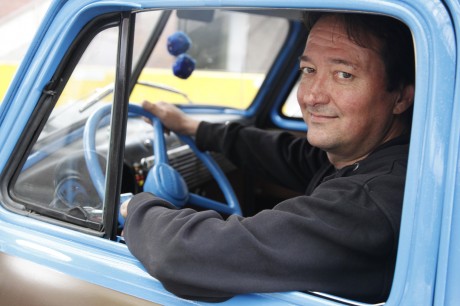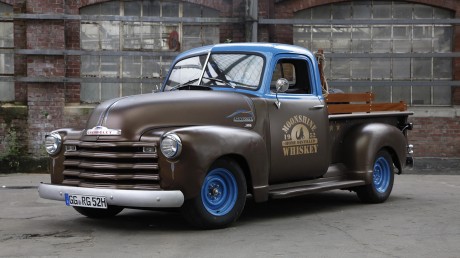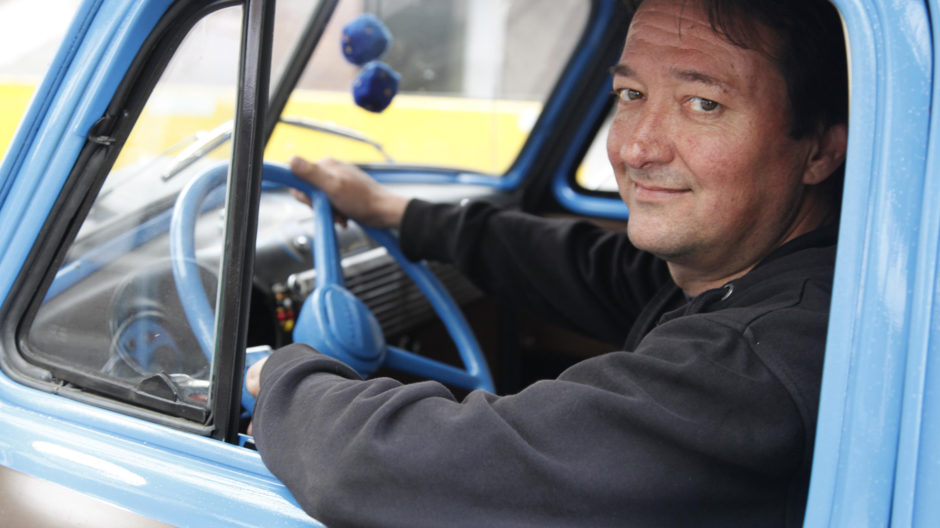
Rüdiger Götz’s reputation precedes him in the vintage car scene in Germany. His meticulous one-off restorations are a joy to behold. A service engineer for Opel’s Aftersales team in Rüsselsheim, Götz has already returned a Kapitän P, a Diplomat B, and a Kadett B Caravan to their former glories. Most recently, the 47-year-old has taken on a 1952 Chevrolet pickup truck, or more correctly, a ‘Series 3100 Half-ton Pickup.’ Not only did Götz restore the mechanical side of this vintage treasure, he also gave it a new identity – as a moonshiner’s truck. Working on this beast of a car took well over a year. Götz says he’s put an estimated 600 hours of tinkering into the Chevy, fitting it around his family duties as best he could. What this usually meant was dropping his sons offfor soccer practice and returning to his garage for a couple of hours while waiting to them up again. Why choose a truck this time round? “I’ve always loved the pickup style, and I’ve always wanted one with a split windshield. So out of the wider GM realm, this was really the only suitable candidate.”

Stick your elbow out the window and assume cruising position: Grease monkey Rüdiger Götz feels right at home in his Chevy pickup truck.
VINTAGE CAR TINKERING: A GLOBAL COMMUNITY
Turning this dream into a reality has demonstrated not only how widely the network of DIY vintage car enthusiasts is established, but also how it has been taken to a new level by the Internet. “Back when I was tinkering on my first babies,” says Götz, “I needed to scour tons and tons of magazines until I’d find the parts I needed, and then I’d spend just as much time again chasing them down on the phone.” Things look a little different in the age of the World Wide Web: Götz found the truck itself on eBay, where it was being sold by company from the Netherlands. “It was in quite a state, most people probably would’ve thought this would go straight to the wreckers,” he says. Götz turned to Google to get a suitable engine. The search returned an address for Corvette Malburg in Gensingen, not too far from Rüsselsheim. Here, he got the 5700 cc V8 monster with 230 horsepower that he was after. The drive shaft and the transmission were also sourced locally. The radiator, however, needed to be ordered from the U.S. – but it only took ten days to get it. As convenient as the Net may be for locating the parts, Götz soon realized: “It’ll take more than a few Google searches in order to bring this Chevy back to life.” As it turned out, the 50-kg front axle also needed to be shipped in from the States, which would’ve been horribly expensive to freight. Luckily, a friend of Götz’s happened to be purchasing a car in the U.S. at the time – so he simply put the axle in the trunk and brought it back to Germany that way. Another acquaintance frequently travels to North America on business and generously offered to pick up whatever spare parts Götz needed, such as rubber sleeves, screws and bolts, and decals.
GETTING STUCK IN: STEEL BRUSH AND ARC WELDER
Finally, Götz got to start on the project proper, which meant having to put all the components together to build a functioning truck. In order to do this, he actually had to break down the remains of the derelict Chevy into its individual nuts and bolts first. The old pickup bed went straight into the fireplace;it was completely rotten with nothing to salvage. The same applied to theupholstery. When it came to the driving cab, Götz lifted this off with a pulley and placed it on a pallet with wheels. This way, he could turn it as needed for getting it back into shape. The undercarriage was subjected to some heavy steel brushing until all the rust and dust was removed, revealing that gleaming Californian steel once again. When it comes to tools, Götz also has a predilection for vintage technologies. His welding system is a 50-year-old arc welder: “That’s the kind of unit I learned how to weld on, I just can’t be bothered with today’s gas-type welders.” Götz was careful not to do too much panel-beating on this mighty truck’s heavy-set exterior: “Some of the dings had to stay, they show that this Chevy’s got a history.” Mechanical updates were added only where absolutely necessary. This included a modern-style braking system and power steering. The safety belts were a science onto themselves, and Götz documented his valiant efforts on his website (www.autoschmiede-goetz.de): “That’s to show all those other grease monkeys out there how it’s done. This was one of the few areas where the Net actually had very little advice to offer.”

Authentic historical flashback: This Chevy truck is a very faithful homage to the cars found in America’s Heartland in the 1950s.
AT THE END, A NEW PAST
Götz would have loved to find out what his Dutch import was used for originally when it was back in the U.S. all those decades ago. But there were no clues as to its former life, so Götz simply invented a new backstory for his truck. He’d recently watched a TV documentary about moonshining, the illegal practice of whiskey distilling that used to flourish in the U.S. during the Prohibition era. The Chevy’s aesthetics seemed to strike a chord with this, and Götz came up with a logo for a would-be distillery: ‘Moonshine Whiskey’ is what the truck is proudly advertising today. To drive home the point, Götz even restored an old oak barrel and added the same logo; this is now is a permanent fixture on the pickup bed. When it came to the technical vehicle inspection, the officer had just one complaint: No windshield wipers. This was fixed very quickly, with a little beer barrel serving as the windscreen water tank – again lacquered and given the official ‘Moonshine’ stamp of approval. The cherry-on-top for the car’s finish was added by Sven Stephan, one of Opel’s design engineers: A set of twirled sky-blue and ocher-colored pin stripes. Rüdiger Götz is absolutely over the moon. “This is a dream come true. I’m never going to sell this truck!”
They’re called ‘flat-bed’ vehicles in Germany and nobody has much time for them beyond their life as a utility vehicle. In the United States, on the other hand, they express the American Way of Life. Light trucks make up almost half of the automotive market in North America. That’s just current sales, but also consider this: “Many people who own a new model still have their old truck at home in the garage,” says Rüdiger Götz. This ubiquity proved a boon for his ambitious restoration project: “I knew that all the spare parts I’d need would still be available in America.” In fact, many of these 60-year-old 3100-series Chevy trucks are still on the roads today.
General Motors began producing the 3100 series in 1947. It was one of the first post-war models to be released by the manufacturer. The 3100 was intended to set new standards for light trucks in terms of style, passenger comfort, and convenience. What sets the Chevy apart from its predecessors and its competitors is its roomy cab. At GM, the design of the cab was commonly referred to as the ‘Unisteel Battleship.’ Instead of offering two separate front seats, this four-wheeled frigate offered a single bench that could easily hold up to three persons. The interior was more colorful than that of any previous Chevrolet, the doors opened wider, and the windows were larger to offer a better panorama. ‘Observation Car Vision’ is how GM described it in its promotional materials at the time. The 3100-series Chevys were amazingly spacious for the early 1950s. ‘Half-tons’ like the one owned by Rüdiger Götz were manufactured until 1953. This wasn’t even the biggest model of the series; there were two even more gargantuan versions. The 3100 series dominated the light truck market right up until 1955.






